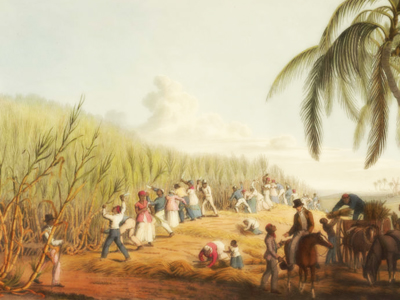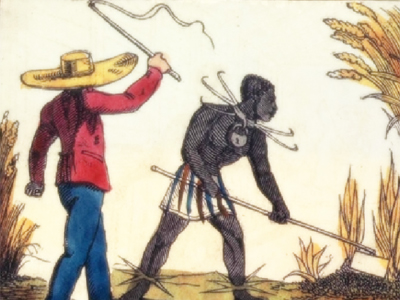|
Enslavement in the Caribbean
"To people in Britain it must seem strange, that there should be a necessity for a law to punish [by] mutilating and dismembering their servants…I know two men, whose neighbours say positively that each of them have murdered scores of their own negroes…the wonder was not that they had buried so many, that they had any above ground. "
Anonymous Jamaican planter
|
Background
Enslaved Africans arrived in the Americas with no family members and no kinship system, unable to reconnect or communicate with those they knew. Their lives now consisted of terror, violence and endless labour. Africans survived for 7-9 years under enslavement. 60 percent of enslaved workers in Jamaica, Britain’s largest colony were found on sugar plantations, where they worked for 18 hours a day, and during the harvest months they worked longer hours and had no rest day. Children were sent to work as soon as they were able, doing tasks such as cleaning, carrying water and collecting grass for livestock. The most skilled jobs went to men, such as the head boiler and mechanic. Women worked alongside men in the fields, undertaking the same physical tasks, as well as the duties of servants, nurses and seamstresses. Enslaved workers also produced other crops including coffee, cocoa, cotton and indigo, and cut and transported mahogany.
|
 Africans sold as chattel, “they are to be seen almost daily exposed for sale…like oxen or sheep”, from Bickells West Indies as They Are 1825 p.19.
© The British Library
| |
Keeping the enslaved under control was foremost in the mind of the plantation owners, and they invested a great deal of time and resources in this endeavour, this on top of having to ensure their businesses remained economically profitable. The laws created to control enslaved populations were indicative of the tensions that existed between the slavers and the enslaved.
|
 Slaves cutting the sugar cane, in Antigua, William Clark, 1823
© The British Library
| |
Any enslaved person was put to death if found guilty of committing serious offences or even suspected of doing so. Beatings and whippings were used as punishment for insubordination, which covered a range of offences including not working fast enough – in fact, any offence deemed by the authorities to be "insubordinate".
"The wharfs of Kingston are crowded every Monday morning with poor slaves…", wrote Thomas Clarkson in his Essay on the comparative efficiency of Regulation of Abolition, "…who are brought here to be whipped for the offences of the preceding week. They are generally tied up by the wrists and stretched out. In that manner they receive their punishment".
|  A slave being punished by a variety of means including flogging, 1826. Whipping or flogging was the most frequent form of punishment and varied in severity. It was possible to die as a result of flogging, for which the perpetrator would often receive nothing more severe than a fine.
© The British Library
|
Narratives from the Collection
Notes on the two reports from the Committee of the Honourable House of Assembly of Jamaica, by a Jamaica Planter
An essay on the comparative efficiency of Regulation or Abolition, as applied to the slave trade
Letters on slavery, by William Dickson, formerly private secretary to the late Hon. Edward Hay, Governor of Barbados
Negro slavery; or a view of some of the more prominent features of that state of society as it exists in the United States of America and in the colonies of the West Indies, especially Jamaica
Account of a shooting excursion on the mountains near Dromilly Estate in the parish of Trelawny, and island of Jamaica in the month of October 1824
Facts Illustrative of the condition of the Negro Slaves in Jamaica
Horrors of West India Slavery
The West Indies as they are; or, a real picture of slavery
|
Test Your Knowledge
|

